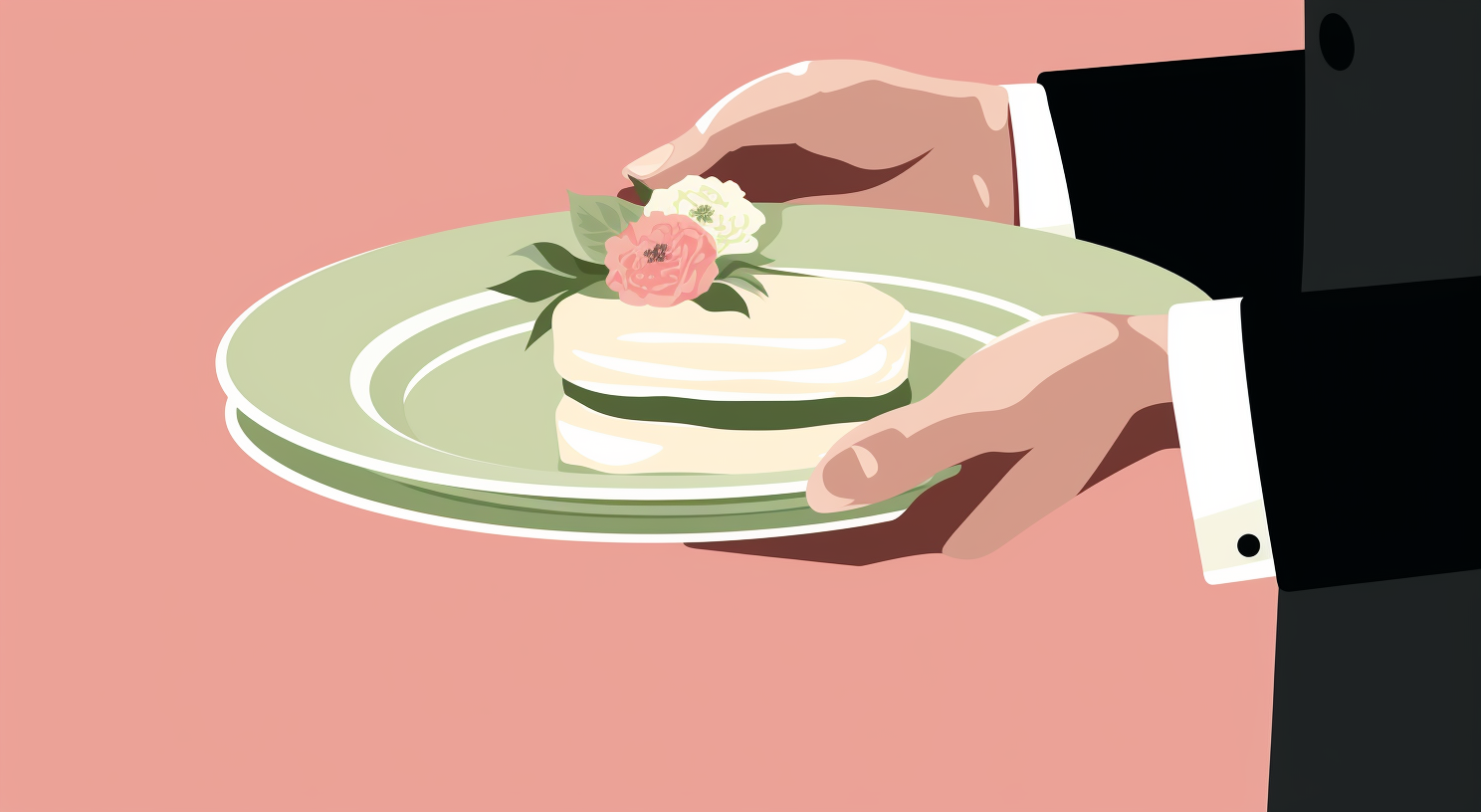Weddings • 05/28/2023
The Average Cost of Wedding Food and 8 Ways to Save

Revivalist is a reader-supported endeavor and our posts may contain affiliate links. When you buy through links on our site, we may earn an affiliate commission.
After you say, “I do!” it’s time for the party. Now’s your opportunity to celebrate your marriage and the next phase of your lives together. Kick it up with dancing, great company and, of course, delicious food. However, you may not know about the average cost of wedding food.
Your mind may still be reeling from the dollar signs in your venue rental, but the fare at your reception and surrounding events will also cost you a pretty penny. Food is typically the second biggest wedding expense. Fortunately, you have many opportunities to save money and still have the party of your dreams.
Average Cost of Wedding Food
The average cost of wedding food is based mainly on the number of guests on your list. The 2022 Real Weddings Study from The Knot, surveying 12,000 couples, found the current estimate is $75 per person for catering. For a reception with 100 loved ones, you could spend $7,500 on food alone.
Common Oversights
Unfortunately, that figure doesn’t represent the whole picture of your wedding food expenses. Couples commonly miss these things when setting their budget:
Rehearsal Dinner
The bride and groom aren’t always the ones who pay for this. However, more couples are taking responsibility for the expense, which can set them back around $1,350, depending on the size of the bridal party and who else you invite.
Breakfast for Bridal Party
Unless you want bridesmaids fainting at the alter, you’ll probably need to feed them something during the day while you get dolled up in hair and makeup. Even a simple breakfast for your ladies will add up.
Place Settings
Check your catering contract carefully. They may not include items like place settings, expecting the venue to take care of those details. If you’re getting married in an unconventional location or they don’t have this service, you’ll need to shell out extra just to have something to put food on.
Alcohol
Unless you have your venue provide the catering, your alcohol bill will be a separate expense from the food. However, it’s an essential part of the reception for most brides and grooms but will add a considerable amount to your total for the wedding.
Dessert
Your wedding cake likely won’t come from the caterer, so you’ll have to consider that expense separately. You must also account for any other dessert items you plan on offering.
Late-Night Snacks
Late-night snacking is becoming a popular wedding tradition. Those who want to stay up and continue the part well into the night will get hungry again. You don’t need expensive fare, but even a dozen or so pizzas will add up.
Morning-After Brunch
Instead of whisking right off to the honeymoon, some couples are opting to enjoy brunch with close family and friends the morning after the wedding. If you’re inviting these people, you may also be expected to cover their food costs.
How to Save on Food Expenses
These tips and tricks can save you significant money for more important things, like the rest of your wedding expenses, honeymoon funds or a down payment on your first home.
1. Pick Cheaper Foods
One of the easiest ways to spend less than the average cost of wedding food is to be flexible with your ingredients. Rather than serving elevated fish and beef dishes like prime rib or ahi tuna, turn to well-prepared chicken or pork. You can have a memorable explosion of flavor without spending a small fortune. Another way to get less expensive foods is to ask for in-season produce and locally sourced ingredients when possible.
2. Opt for a Buffet or Family Style
A sit-down meal is the most expensive option for weddings, largely because it requires the most serving staff. Your caterer would need to hire enough people to bring the plates of food to each guest and clear away at the end. To save some serious cash, you can choose a buffet or family-style meal instead. With these methods, you need far fewer wait staff to run an event since guests can serve themselves from larger dishes at a separate table or spread along their own.
3. Serve Brunch
The time of day you choose for your reception will also factor into the cost of food for your wedding. Meals served in the evening tend to be larger and heavier than earlier in the day — and cost more money. A brunch reception with eggs, potatoes, ham, sausage and pancakes would be much easier on your budget. If you’re dead set on an evening meal, simply embrace the breakfast-for-supper theme.
4. Party Outside Mealtimes
With some forethought and extra planning, you may not even need to serve an official meal to your guests. For example, a 1 or 2 o’clock wedding would allow a 3 o’clock reception, with the party wrapping up between 6 and 7. Now, your loved ones will probably still get peckish if you give them nothing, so have some cold platters ready for snacking. Meat and cheese, fruits and veggies and sandwich fixings are all great options.
5. Serve Platters for Hors D’oeuvres
Those same platter work really well in the place of traditional hors d’oeuvres. During cocktail hour, waiters typically carry around trays of small bites for the guests. However, this method increases staffing needs. These tiny delicacies also tend to take more time to make and use premium ingredients. Eliminating passed hors d’oeuvres will help you stay on track with your wedding budget.
6. Scale Back the Cake
The cake and assorted desserts usually aren’t part of a catering package, so you’ll need to purchase those separately from a baker. Traditional tiered wedding cakes are gorgeous to look at but can get outrageously expensive. Cut down on costs by reducing the size of your cake. You could have a one-layer cake for your special pictures and then serve the rest of your guests a different dessert or from a sheet cake. You could also opt for a tiered cake where the base layers are foam on the inside and purely for decoration.
Even though sheet cake may seem like a cheap way to go, your guests will likely never know, and they’ll be much more satisfied because buttercream tastes much better than fondant. Plus, tiered cakes must be stale to handle the decorations and stacking process. Sheet cakes are fresh.
7. Stick to Wine and Beer
Alcohol is another item commonly forgotten when budgeting. It’s an integral part of the festivities for most couples. However, it doesn’t always fall under the venue contract and is not usually supplied by the caterer. If you order the alcohol yourself, you can cut costs by sticking to wine and beer. You can buy these in bulk for decent rates, and your guests will still enjoy themselves. A few dozen bottles of wine and a few kegs could save you thousands over having an open bar with all the liquor options.
8. Cut Down the Guest List
The easiest way to stay under the average cost of wedding food is to cut your guest list. Each person you invite to your wedding is an added expense. When you need to save money, you must prioritize the loved ones you need there versus the people you’d like to have.
Lower Your Average Cost of Wedding Food
While the national average is currently almost $80 a person just for reception food, you can bring your costs down substantially by using one or more of these tips. While eating in some form is a traditional part of the wedding, it’s not the end all be all. Your guests will be more excited about the dancing and socializing, celebrating your union, so take some pressure off yourself and enjoy this time.
Subscribe to Our Weekly Newsletter
We would love to connect deeper with you!


